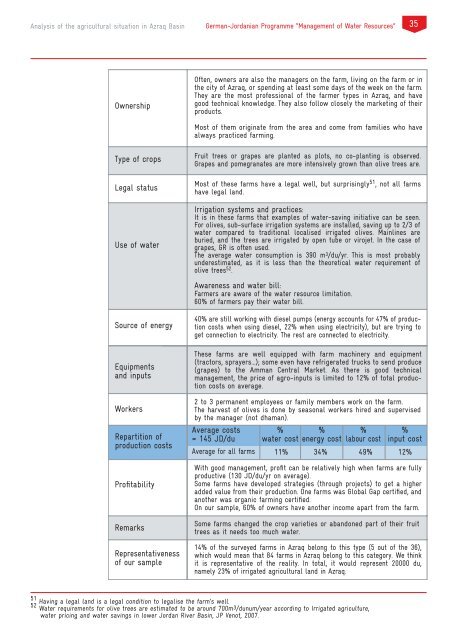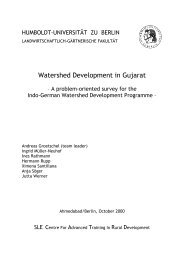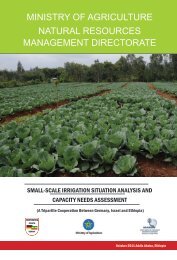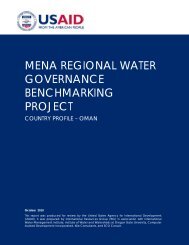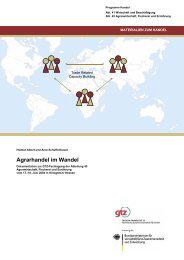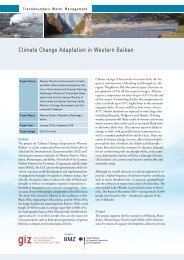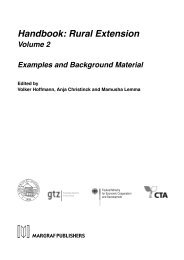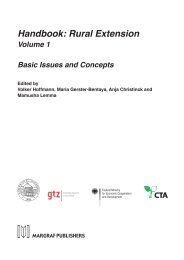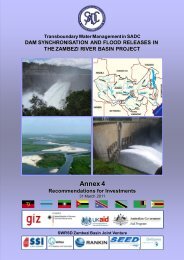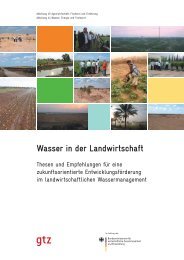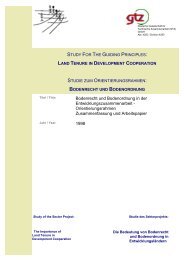Farming in the - WordPress.com
Farming in the - WordPress.com
Farming in the - WordPress.com
You also want an ePaper? Increase the reach of your titles
YUMPU automatically turns print PDFs into web optimized ePapers that Google loves.
Analysis of <strong>the</strong> agricultural situation <strong>in</strong> Azraq Bas<strong>in</strong><br />
German-Jordanian Programme “Management of Water Resources”<br />
35<br />
Ownership<br />
Often, owners are also <strong>the</strong> managers on <strong>the</strong> farm, liv<strong>in</strong>g on <strong>the</strong> farm or <strong>in</strong><br />
<strong>the</strong> city of Azraq, or spend<strong>in</strong>g at least some days of <strong>the</strong> week on <strong>the</strong> farm.<br />
They are <strong>the</strong> most professional of <strong>the</strong> farmer types <strong>in</strong> Azraq, and have<br />
good technical knowledge. They also follow closely <strong>the</strong> market<strong>in</strong>g of <strong>the</strong>ir<br />
products.<br />
Most of <strong>the</strong>m orig<strong>in</strong>ate from <strong>the</strong> area and <strong>com</strong>e from families who have<br />
always practiced farm<strong>in</strong>g.<br />
Type of crops<br />
Legal status<br />
Use of water<br />
Fruit trees or grapes are planted as plots, no co-plant<strong>in</strong>g is observed.<br />
Grapes and pomegranates are more <strong>in</strong>tensively grown than olive trees are.<br />
Most of <strong>the</strong>se farms have a legal well, but surpris<strong>in</strong>gly 51 , not all farms<br />
have legal land.<br />
Irrigation systems and practices:<br />
It is <strong>in</strong> <strong>the</strong>se farms that examples of water-sav<strong>in</strong>g <strong>in</strong>itiative can be seen.<br />
For olives, sub-surface irrigation systems are <strong>in</strong>stalled, sav<strong>in</strong>g up to 2/3 of<br />
water <strong>com</strong>pared to traditional localised irrigated olives. Ma<strong>in</strong>l<strong>in</strong>es are<br />
buried, and <strong>the</strong> trees are irrigated by open tube or virojet. In <strong>the</strong> case of<br />
grapes, GR is often used.<br />
The average water consumption is 390 m 3 /du/yr. This is most probably<br />
underestimated, as it is less than <strong>the</strong> <strong>the</strong>oretical water requirement of<br />
olive trees 52 .<br />
Awareness and water bill:<br />
Farmers are aware of <strong>the</strong> water resource limitation.<br />
60% of farmers pay <strong>the</strong>ir water bill.<br />
Source of energy<br />
Equipments<br />
and <strong>in</strong>puts<br />
Workers<br />
Repartition of<br />
production costs<br />
Profitability<br />
Remarks<br />
Representativeness<br />
of our sample<br />
40% are still work<strong>in</strong>g with diesel pumps (energy accounts for 47% of production<br />
costs when us<strong>in</strong>g diesel, 22% when us<strong>in</strong>g electricity), but are try<strong>in</strong>g to<br />
get connection to electricity. The rest are connected to electricity.<br />
These farms are well equipped with farm mach<strong>in</strong>ery and equipment<br />
(tractors, sprayers...); some even have refrigerated trucks to send produce<br />
(grapes) to <strong>the</strong> Amman Central Market. As <strong>the</strong>re is good technical<br />
management, <strong>the</strong> price of agro-<strong>in</strong>puts is limited to 12% of total production<br />
costs on average.<br />
2 to 3 permanent employees or family members work on <strong>the</strong> farm.<br />
The harvest of olives is done by seasonal workers hired and supervised<br />
by <strong>the</strong> manager (not dhaman).<br />
Average costs<br />
= 145 JD/du<br />
Average for all farms<br />
%<br />
water cost<br />
%<br />
energy cost<br />
%<br />
labour cost<br />
%<br />
<strong>in</strong>put cost<br />
11% 34% 49% 12%<br />
With good management, profit can be relatively high when farms are fully<br />
productive (130 JD/du/yr on average).<br />
Some farms have developed strategies (through projects) to get a higher<br />
added value from <strong>the</strong>ir production. One farms was Global Gap certified, and<br />
ano<strong>the</strong>r was organic farm<strong>in</strong>g certified.<br />
On our sample, 60% of owners have ano<strong>the</strong>r <strong>in</strong><strong>com</strong>e apart from <strong>the</strong> farm.<br />
Some farms changed <strong>the</strong> crop varieties or abandoned part of <strong>the</strong>ir fruit<br />
trees as it needs too much water.<br />
14% of <strong>the</strong> surveyed farms <strong>in</strong> Azraq belong to this type (5 out of <strong>the</strong> 36),<br />
which would mean that 84 farms <strong>in</strong> Azraq belong to this category. We th<strong>in</strong>k<br />
it is representative of <strong>the</strong> reality. In total, it would represent 20000 du,<br />
namely 23% of irrigated agricultural land <strong>in</strong> Azraq.<br />
51 Hav<strong>in</strong>g a legal land is a legal condition to legalise <strong>the</strong> farm’s well.<br />
52 Water requirements for olive trees are estimated to be around 700m 3/dunum/year accord<strong>in</strong>g to Irrigated agriculture,<br />
water pric<strong>in</strong>g and water sav<strong>in</strong>gs <strong>in</strong> lower Jordan River Bas<strong>in</strong>, JP Venot, 2007.


